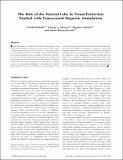The Role of the Parietal Lobe in Visual Extinction Studied with Transcranial Magnetic Stimulation
Author(s)
Battelli, Lorella; Alvarez, George A.; Carlson, Thomas; Pascual-Leone, Alvaro
DownloadBattelli-2009-The Role of the Parietal Lobe in Visual Extinction Studied with Transcranial Magnetic Stimulation.pdf (183.0Kb)
PUBLISHER_POLICY
Publisher Policy
Article is made available in accordance with the publisher's policy and may be subject to US copyright law. Please refer to the publisher's site for terms of use.
Terms of use
Metadata
Show full item recordAbstract
Interhemispheric competition between homologous areas in the human brain is believed to be involved in a wide variety of human behaviors from motor activity to visual perception and particularly attention. For example, patients with lesions in the posterior parietal cortex are unable to selectively track objects in the contralesional side of visual space when targets are simultaneously present in the ipsilesional visual field, a form of visual extinction. Visual extinction may arise due to an imbalance in the normal interhemispheric competition. To directly assess the issue of reciprocal inhibition, we used fMRI to localize those brain regions active during attention-based visual tracking and then applied low-frequency repetitive transcranial magnetic stimulation over identified areas in the left and right intraparietal sulcus to asses the behavioral effects on visual tracking. We induced a severe impairment in visual tracking that was selective for conditions of simultaneous tracking in both visual fields. Our data show that the parietal lobe is essential for visual tracking and that the two hemispheres compete for attentional resources during tracking. Our results provide a neuronal basis for visual extinction in patients with parietal lobe damage.
Date issued
2009-10Department
Massachusetts Institute of Technology. Department of Brain and Cognitive SciencesJournal
Journal of Cognitive Neuroscience
Publisher
MIT Press with the Cognitive Neuroscience Institute
Citation
Battelli, Lorella et al. “The Role of the Parietal Lobe in Visual Extinction Studied with Transcranial Magnetic Stimulation.” Journal of Cognitive Neuroscience 21 (2009): 1946-1955. © 2008 Massachusetts Institute of Technology.
Version: Final published version
ISSN
1530-8898
0898-929X